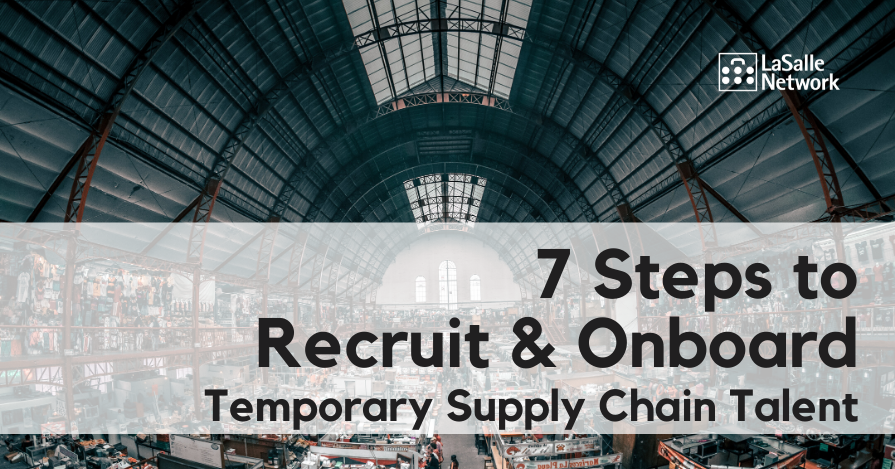Since the very start of the spread, COVID-19 has disrupted supply chains and distribution on a global level. From empty grocery store shelves to toilet paper and hand sanitizer shortages, supply chain disruptions are likely to continue even after shelter-in-place mandates have ended. While some businesses have seen a sharp decline, others have had a drastic increase in demand and are in the process of adapting to changes throughout their supply chain. Whether it is due to disruptions or increased demand, many supply chains likely need immediate temporary support.
Below, we‘re sharing 7 tips for recruiting and onboarding contract supply chain employees.
Write an effective job description. Speak to the hiring manager about what responsibilities would be given to the contract employee, then pull from past job descriptions to compile the ideal qualifications. If this is a newly created role, talk to whomever is covering the responsibilities now to understand what the contract worker will be doing and what skills are required. Depending on the role, you should include relevant skills or software knowledge in the description.
An honest and detailed job description is worth taking the time to write to maximize recruiting efforts and avoid interviewing and hiring individuals who would not work through their entire contract.
Be honest about the motivation to hire contract workers. Be transparent regarding whether the position could become permanent, and if the role is due to COVID-19. It is possible that you may not know how long the contract will go, and employees should be prepared to be flexible. Acknowledge the uncertainty of today’s market. Depending on future disruptions to supply or demand, their roles may shift or extend.
Source talent effectively. Taking shortcuts to skip interviews or background checks can result in hiring unqualified employees, leading to lower productivity and higher turnover.
Ask for referrals from current employees. Even if the position is entry level, a supply chain under great demand cannot tolerate mistakes or inconsistency, nor invest additional time and resources in replacing employees who fail to work through their entire contract. It is likely your staff have family or friends who have experience in supply chain or who are out of work and referrals are more likely to perform well and work throughout the duration of their contract.
Consider utilizing staffing firms. In a period of high unemployment, posting a job means that you will receive a flood of applicants, with the large majority being unqualified. Staffing firms are accustomed to weeding through high volumes of applicants and identifying those will the skill set to succeed. These firms can be used to search for qualified candidates, interview and assume some of the risk that goes along with contracting workers, including providing benefits and paying out unemployment after the contract ends. Staffing firms can also assist with onboarding, orientation and training of contract workers. They typically maintain a large pool of qualified candidates and can deploy large groups of temporary workers very quickly.
Onboard remotely. Do as much ahead of time as possible to ensure the employee can hit the ground running on their first day. If the employee can be onboarded remotely, be sure to have them complete initial Human Resources paperwork (Offer Letters, Benefits, Non-Compete Agreements, Work from Home Agreements) when they return their acceptance letter.
Set up a video call to discuss expectations, such as work hours and company policies, beforehand. Gauge the employee’s knowledge of any software they will need to be familiar with and, if necessary, send them tutorials in advance. Consider your commonly used channels for communication such as chat or video conferencing, resource sharing and procurement automation tools. Many commonly used tools have online tutorials, such as Prokuria or Procurify.
Prepare for a fast, efficient orientation. If possible, onboard and train contract workers as a group to save time and resources. This will prevent repetition by efficiently explaining how to log hours, who to contact with questions and outline COVID-19 and other safety precautions.
Everything should be ready for the employees before they walk in the door (be it a virtual front door or real!), from desk and IT set up to badge and credentials. Desks should be assigned and log in information prepared, if applicable. Provide both written and verbal communication of expectations regarding what they are expected to complete while working and how they will be evaluated.
Give a tour of the facility to demonstrate safety regulations as well as Coronavirus prevention strategies. If employees are in a warehouse, assign the sections each will be working on and walk them through their process.
Introduce contract employees to the managers and teams they will be working alongside. For example, those working in procurement may work closely with the finance team and should be introduced to their team contacts and trained on best practices for communicating throughout the day.
Leverage labor management technology. While in an especially busy season, utilizing this technology in tandem with your warehouse management system can help to efficiently monitor individual and group performance and review associated performance metrics. This can help mitigate potential issues and maximize each contract worker’s performance.
While managing employees throughout their contract, be sure to communicate changes in demand, hours or contract length regularly. Set aside time every week to speak with the contract hires to check in on progress and give them an easy outlet for seeking help. Consider holding a mid-project review to track progress and performance and touch base considering potential changes to the length of their contract.
Are you hiring temporary or permanent workers? Contact us.




